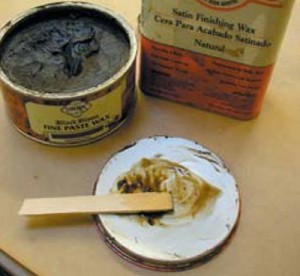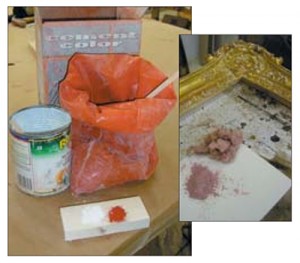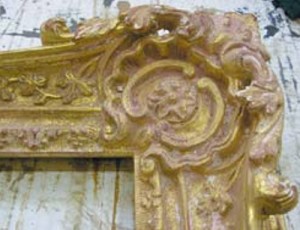Creating a Unique French Period Patina
As promised in my last article, “Spanish Wash,” this piece will cover creating a French soda wash finish with a special pink dust. The story goes way back to 1967, when I first moved from Long Island into Manhattan. The late Fifties and the early Sixties were a time of great change in the art world. Like most art students at the School of Visual Arts, I was blown away by the Abstract Impressionists of this period. Pollock, Rauschenberg, Motherwell, and many more were turning the art world around. Being an art student in Manhattan allowed me to see the work of this school first hand. Going to the Castelli Gallery or Marlboro Gallery for openings or to the Whitney, Guggenheim, and Museum of Modern Art was all that any art student could hope for. But I was also a framemaker. So my eye was always torn between the welded aluminum frames of the day and the world of antique originals and replications out there.
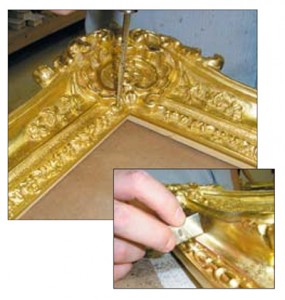
Whenever or wherever I would walk to art shows up or down Madison Avenue or east or west on 59th Street, there was always a juxtaposition from gallery to gallery of the modern and the much more traditional. The great art that was being sold in high-end, established galleries was painted by European Impressionists—Monet, Manet, Cezanne, and the rest. I thought they should have been framed in floaters, those 3/8″ or 5/8″ gold bands with the black shadow all around them. Boy, was I wrong! They should have been framed in the frames that the artist placed on them, white painted period frames. These artists were breaking all the rules,
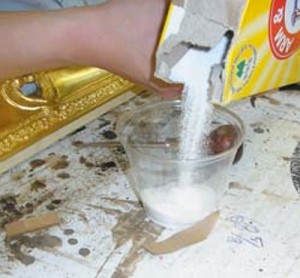
so by painting over the gold or by using gessoed-only frames they were very avant garde. But to sell these master-pieces at a high dollar price, even in the Fifties and Sixties, the patrons and the galleries decided the frames needed a little help. And that is where the wonderful French soda finish was born.
First, be warned that you can lose a frame very easily with this technique. You’ll be working on unsealed gold, so pay attention and don’t walk away from a frame between steps.
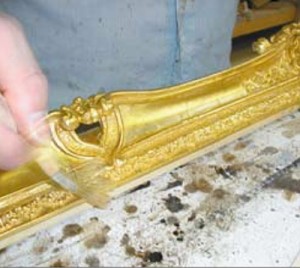
For this project, I wanted a really beautiful French sweep with carved corners and centers for this patina. So, I called Rhonda Feinman, who suggested a 3″ Louis XV closed corner frame with small centers. She sent it in gesso with ornaments all re-carved, sanded, and ready for clay. We sprayed it in yellow clay and glazed on three light coats of red/orange clay.
After adding some distress work, the first step was trying to find Arm & Hammer Super Washing Soda. Being in Santa Fe, we found no
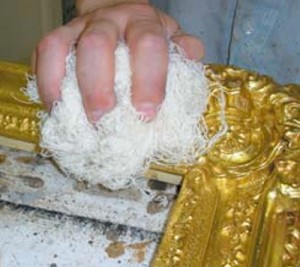
grocery store or hardware store that carried it. Through the Internet, we found it at Gristedes in Manhattan. I should have remembered this, but age is catching up with me. Well, enough nostalgia.
We distressed the frame with an ice pick and razor blades. We then mixed the soda wash at six tablespoons to six ounces water. Brushing it on is easy as long as you don’t forget all the nooks, crannies, and overs and unders of a French frame. Take your time and don’t
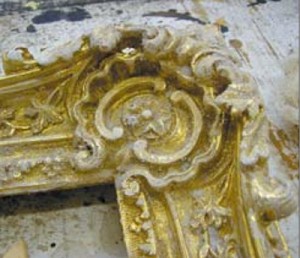
miss anything. Tamp it back with a rag and cotton waste and stand back and watch. Because the washing soda is sodium carbonate, when mixed with water and put on gold it starts to turn from a liquid to a corrosive solid that eats away the leaf. It is a wonderful acid wash and when dry you can go at it with all sorts of tools. We tried wet steel wool and rasps at first, but we found that a steel brush worked best.
We could control the rub and how much white we wanted to remove or leave. Remember, gallery owners and patrons then and now don’t want white
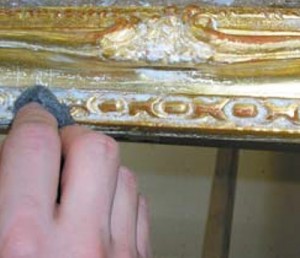
frames. So, by using the soda you can get a crossover between a white painted frame and a gilded frame with white in the carves.
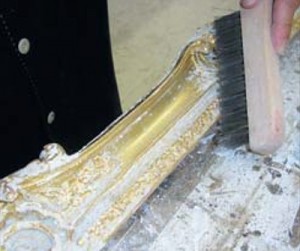
The next step was to spatter the surface of the gold with raw umber artist pigment and clear shellac thinned with denatured alcohol. This not only creates a great look of translucency, but it also seals the surface. To keep the light pastel finish going, we used a wonderful colored wax in medium oak (which is a raw umber color) from Liberon and
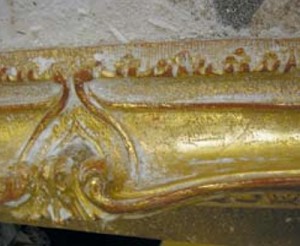
thinned it with a clear liquid wax to keep the translucency of the patina. But the look of the frame with the white left in the carved areas was a little harsh. So, as the story goes, the Wildenstein Gallery suggested toning down the white with pink dust to work with a specific painting. To make pink dust, mix red cement color with whiting.
Well, you can see what a wonderful patina this is. It’s a shame that I only get an opportunity to do a frame with a French soda finish and pink dust every 30 years.
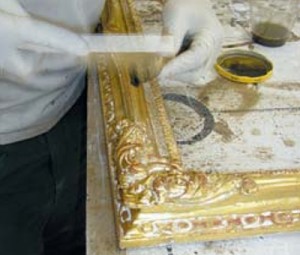
See you in Vegas!
